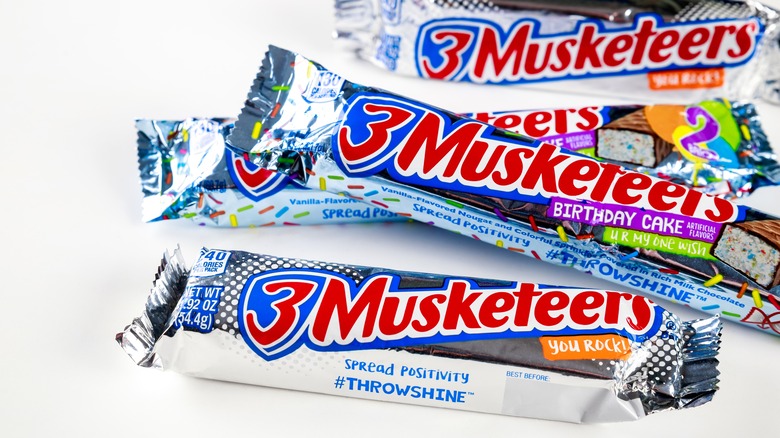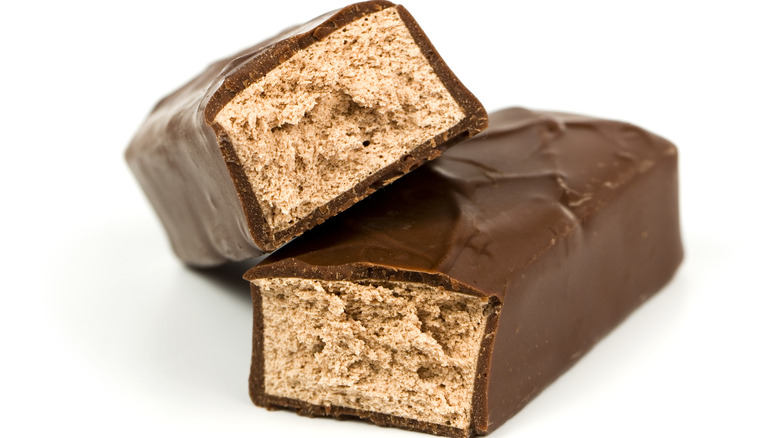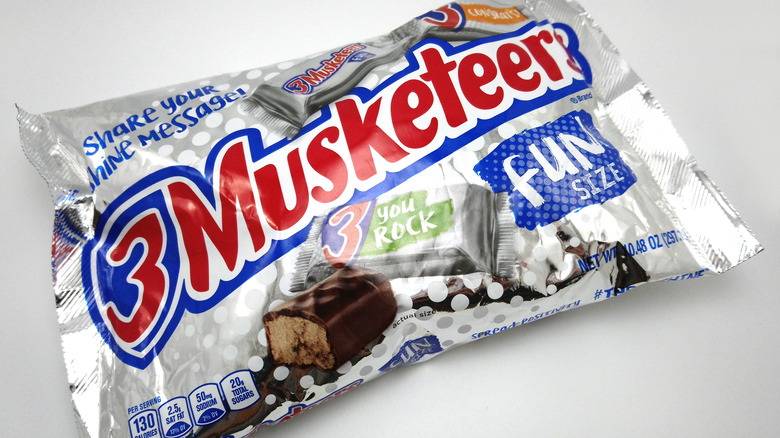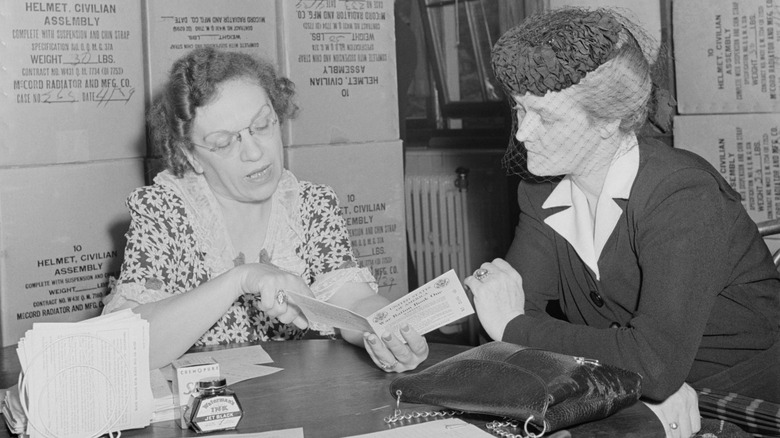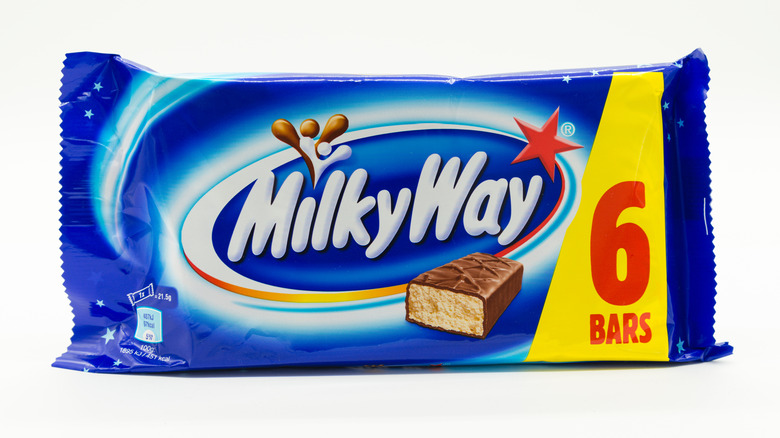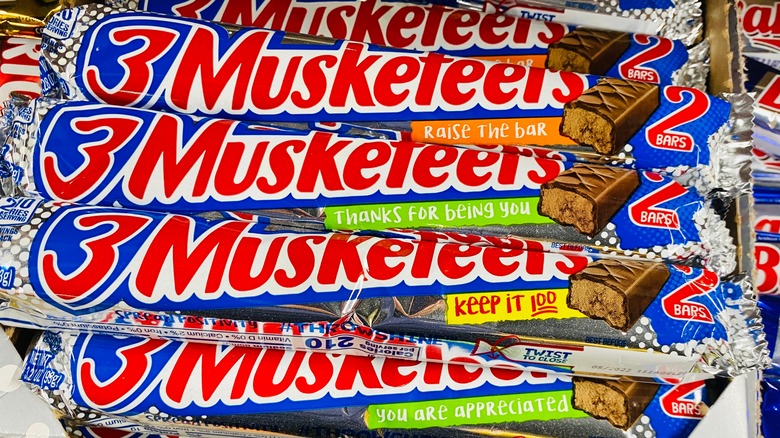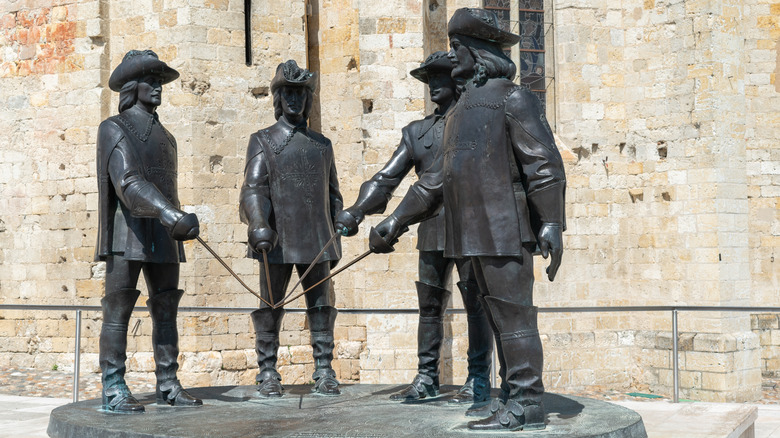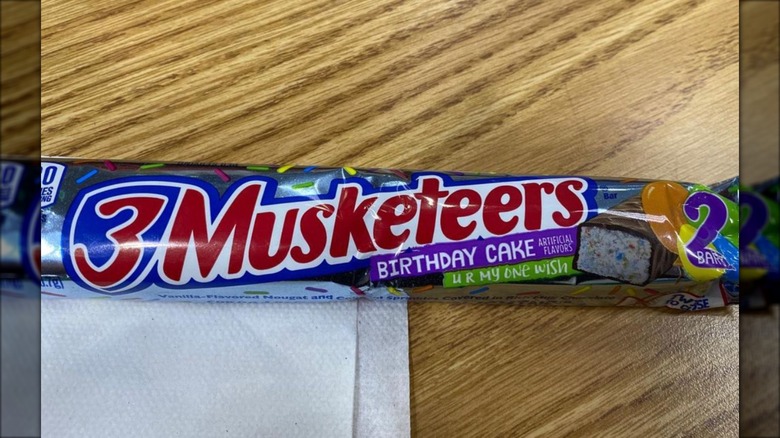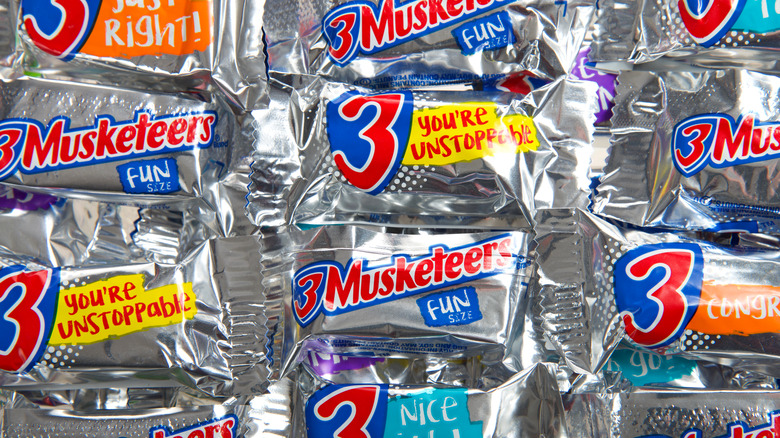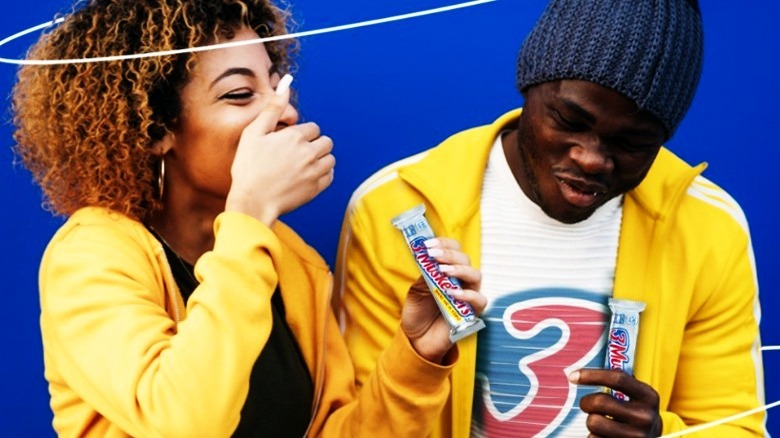The Untold Truth Of 3 Musketeers
Candy bars are truly one of the life's simplest pleasures — unless, of course, you're talking about 3 Musketeers. Sure, this jewel in the crown over at Mars Wrigley brands is based on the simplest of concepts: chocolate nougat covered in milk chocolate (via 3 Musketeers). It's simply one easy-to-love layer of straight-up sweetness and creamy mouthfeel. Yet, if the 3 Musketeers has only two essential elements, then what's up with the number "three" in the title? Moreover, since said branding is a reference to a classic work of 19th French literature, the swashbuckling adventure novel by Alexandre Dumas, that just beg another question: if it's such a simple candy bar, then what's with the lofty name?
Then there's the whole matter of the dichotomy between 3 Musketeers' name recognition and its popularity. While 3 Musketeers stands among the top 10 most popular chocolate candy bars in the U.S. it's just barely maintaining its foothold in that pantheon (via Statista). Meanwhile, in Europe, it's the total reverse. There, people apparently love 3 Musketeers. Indeed, they just aren't familiar with the name, as we'll soon learn. For now, let's just say, we need to talk about this low-key global icon. So, join us, won't you? Let's take a bite out of the untold truth of 3 Musketeers.
What's actually inside a 3 Musketeers bar
The 3 Musketeers chocolate candy bar is a veritable monument to candy bar simplicity, consisting of a single layer of fluffy chocolate candy surrounded by a much thinner layer of milk chocolate. That outer chocolate layer is soft enough to crack gently when bitten into and melts easily on the tongue (or the fingers, if one is not careful). The inside layer, which the 3 Musketeers website refers to as "nougat," has a soft, whipped, and pliable consistency. Its mild chocolate flavor becomes more concentrated as it melts in the mouth, sort of the way cotton candy does.
In appearance, this filling is not unlike a chocolate milkshake. In fact, a chocolate malted is precisely what it was meant to taste like when it was first introduced by Mars. in 1923 as one of the two layers of candy inside a Milky Way (the other being soft caramel), per Mars.
Yet the first thing you might notice when you bite into the nougat layer of a 3 Musketeers is how little it resembles what most candy confectioners think of as nougat. The classic nougat that has been popular for centuries in Europe and the Middle East is far different, in fact. Unlike the soft, frothy nougat layer of a 3 Musketeers bar, classic nougat is a densely chewy and teeth-achingly sticky confection made from egg whites and honey, according to Honey Traveler.
When 3 Musketeers began, it had a completely different concept
The 3 Musketeers bar was introduced in 1932, making it the third mass-marketed chocolate candy bar from Mars, itself a predecessor company of the current Mars-Wrigley company (per Mars). The first was the Milky Way bar, which debuted in 1923 and was marketed as "double malted milk in a candy bar." The next was the Snickers bar, which came along in 1930. Like Milky Way, Snickers includes a nougat layer and a caramel layer, but unlike the Milky Way, its caramel layer is studded with peanuts.
If it strikes you as curious that, for its third chocolate candy bar, Mars would dispense with the caramel layer altogether, there's an explanation. That's because that wasn't really all that Mars had in mind when it developed the 3 Musketeers.
As originally conceived, the 3 Musketeers bar was actually three one-ounce candy bars wrapped in a single packageThose three candy bars were entirely distinct from onen another. Only one of the trio was filled with the chocolate nougat that's inside a modern 3 Musketeers bar. The others were filled with vanilla nougat and strawberry nougat, according to WorthPoint.
Why 3 Musketeers dispensed with its original idea
The 1932 launch of 3 Musketeers as three one-ounce bars, each featuring a different flavor of nougat, was an unqualified success, according to Mars. This is noteworthy in part. because 1932 was the height of the Great Depression, which began in October 1929 and continued throughout most of the 1930s, according to Britannica.
In fact, the easy share-ability of the original five-cent 3 Musketeers bar was what made the new candy bar succh a hit, as the Belleville News-Democrat reports. The success of 3 Musketeers continued all the way through the Great Depression and into the first few years of World War II, which began in Europe in 1939. The war saw 3 Musketeers included in American soldiers' wartime rations — a cause for celebration for both Mars and the soldiers alike.
In 1942, however, the U.S. government initiated wartime rationing of sugar and other items. This added a new layer of complexity to the candy bar manufacturing process, including increased costs and limited supply. In response, Mars decided to scrap the vanilla and strawberry nougat flavors. The company instead chose too focus solely on producing a single chocolate nougat-based bar, one that was bigger than the original one-ounce size but considerably smaller than the original three-ounce package. Mars has never really veered from this format since, with the exception of limited time offerings of novelty flavors.
In Europe, the 3 Musketeers is sold as a Milky Way
If you're ever in Europe and craving a 3 Musketeers bar, we've got good news and bad news. The bad news is that you won't be able to find 3 Musketeers bars through normal retail channels. That's because 3 Musketeers bars are technically. not sold in Europe — at least not under the brand name familiar to most Americans.
The good news, however, is that the candy bar that we think of in the U.S. as a 3 Musketeers is marketed in Europe, but only under the name "Milky Way" (via Welcome to Germerica). To be clear, the candy bar marketed in Europe as a Milky Way contains no caramel at all, according to Polish national Marcin Tulinski, who spoke to Mashed. British-born Amanda Ansell confirmed via text that the same is true in the United Kingdom.
All of this might explain how it is that the BBC-affiliated Quite Interesting Twitter was able claim that the European Milky Way will float, while the American version will sink straight to the bottom. As Cal State Bakersfield's Department of Chemistry illustrates in a simple do-it-at-home science experiment, 3 Musketeers bars do indeed float, whereas American Milky Way bars do not. Oh, and by the way, if you're looking for an American Milky Way in Europe, simply go with the Mars bar.
Did Mars mess up its labeling of 3 Musketeers?
Given that what we think of as a 3 Musketeers bar in the U.S. is actually marketed as a Milky Way bar in Europe, it's not particularly surprising that some people are confused. Some believe that 3 Musketeers was originally supposed to have been called Milky Way, while Milky Way was supposed to have been called 3 Musketeers. According to Snopes, the reasoning is that a Milky Way sounds like it should be the name of a candy that tastes predominantly like a chocolate malted milkshake (as a 3 Musketeers does).
By contrast, 3 Musketeers sounds like it should be the name of a candy comprised of three layers (as Milky Way is, with its chocolate, nougat, and caramel). As the story goes, the candy bars were accidentally switched at birth, meaning that the fluffy, nougat-centric 3 Musketeers ended up in the Milky Way wrapper, and vice versa. By the time someone realized the mistake had been made, it was too late to switch. The candy bars had already made their big debuts.
But it's important to remember that this is just an unverified story. In fact, this story is impossible, given that Milky Way was already in production for more than a decade before 3 Musketeers launched. Further, 3 Musketeers derives its name not from the caramel layer but from the title of a 19th century novel by Alexandre Dumas (per WorthPoint).
Was 3 Musketeers named after a French novel?
If you've been following along so far, then you are probably no longer wondering why Mars didn't give the name Milky Way to the candy bar that became 3 Musketeers. That's because you know that name was already taken by the actual Milky Way bar, as per Mars. You probably also can guess why Mars decided to name the 3 Musketeers bar after Alexandre Dumas' classic 19th century adventure novel. Of course, that only works if we ignore the fact that, in the novel, the addition of D'Artagnan makes for four Musketeers (via Britannica).
The 3 Musketeers bar originally consisted of three separate one-ounce bars of candy, according to WorthPoint. With each of those bars containing a different flavor of whipped nougat inside, the 3 Musketeers name makes sense. Piling on the three symbolism, need we mention here that the 3 Musketeers bar was actually the third chocolate candy bar product that the Mars company mass-marketed? In other words, there are quite a few "three" references that go along with the 3 Musketeers candy bar.
The thing is, Mars could have gone with anything that came in three, like the Three Stooges. So, why the "Three Musketeers"? Our working theory is that Mars was hoping the brand name would reinforce the idea that those three one-ounce candy bars came together, just like those French guys with swords. Or as the Musketeers might have said, "all for one, and one for all."
3 Musketeers may bring back a unique flavor
In 1942, in response to the U.S. entering World War II and subsequent rationing, Mars shut down production of its the strawberry and vanilla nougats it was using in its three separate 3 Musketeers bars. The company chose to carry on with a new all-chocolate-all-the-time theme (via WorthPoint). When the war ended, Mars kept things status quo all the way until 2007, with one exception. The late 1980s saw 3 Musketeers come out in the form of an ice cream bar (via Twitter). If you think about it, the move made perfect sense, given that the nougat in the 3 Musketeers was meant to taste like that frozen beverage treat, the chocolate malted milkshake.
But it wasn't until 3 Musketeer's platinum jubilee that the company began experimenting in earnest with limited edition runs of various flavors of nougat. These included vanilla, strawberry, cappuccino, mint, orange, s'mores truffle crisp, coconut, hot chocolate, marshmallow, and birthday cake. Two flavors, cherry and raspberry, came with a dark chocolate coaking (per Snack History and Belleville News-Democrat).
We can't say for sure whether 3 Musketeers will bring any of these back in the near future. However, if you happen to feel strongly about the three flavors of mint, strawberry, or birthday cake, you'll be able to weigh in on 3 Musketeers' website. As of May 2022, mint is in the lead with 43% of the votes, followed by strawberry (30%) and birthday cake (27%).
Why your kid can't sell 3 Musketeers bars
Girl Scouts sell their own ultra-popular cookies to raise funds for their troops but, for the rest of the world of fundraising, candy is perfectly dandy. And if you've got a sports team, a marching band, a music school, or the like, you'll have myriad options when it comes to a sweet money-maker. For starters, there's World's Finest Chocolate, which the Chicago Tribune has called one of the largest players in this sort of small-scale fundraising endeavor. There's also Toblerone, the candy whose enduring popularity may owe a great debt to the brand's reliable popularity in small-scale fundraising (per Fundraising Express). But you know which candy you'll never find participating in such ventures? That would be 3 Musketeers, at least not through any official company-sanctioned program. That said, you may be able to purchase fundraising packs that include 3 Musketeers.
Even if you were to ask super politely, here's what 3 Musketeers would tell you, according to its FAQ: "We applaud your efforts to create smiles and better moments in your community! As much as we would like to play a part, we do not accept product donation requests from consumers."
To its credit, however, 3 Musketeers focuses on supporting the work done by the Mars Wrigley Foundation, which is geared toward improving the lives of those living in mint and cocoa growing regions.
3 Musketeers are surprisingly low fat
For the last two years of the 20th century, dietary fat was villainized, as PBS reports. Although the reasons seemed science-backed at the time, many missed an essential nuance: not all fats are "bad." Nevertheless, it was in that context that 3 Musketeers took to marketing itself as the candy with 45% less fat than its competitors, according to WorthPoint. In fact, it still does today (via Instacart). For anyone who still regards dietary fat as a macro nutrient non grata, then 3 Musketeers, which contains 7 grams of fat per serving (4.5 of which are saturated), might well be the obvious and educated choice.
However, for anyone with a deeper understanding of dietary macros, there are other factors to consider. For example, a standard-sized 3 Musketeers bar has 1 gram of protein and 42 grams of carbs, 36 of which come from added sugars, according to 3 Musketeers. By contrast, a Snickers bar, which has 12 grams of fat (4.5 saturated), contains significantly more protein (4 grams), around 23% fewer carbs, and about 27% less sugar than a 3 Musketeers.
Considered in this light, neither 3 Musketeers nor Snickers is a wise dietary choice, according to the American Heart Association. Teh AHA recommends limiting daily sugar intake to under 36 grams per day for men and 25 grams per day for women. However, if you happen to be looking for a lower-fat chocolate candy option, then 3 Musketeers is still your logical choice.
3 Musketeers and Gen Z: a slow burning love story?
Ninety years in, 3 Musketeers is still one of the nation's most popular candy bars, even though it flexes nowhere near the advertising muscle of other candies like Snickers and M&M's. As Digiday noted in 2016, it's been quite a while since the candy was part of a concerted marketing campaign. That said, 3 Musketeers was, at the time, in the process of rolling out a digital-only campaign in the hopes of making an impression on the up-and-coming generation du jour: Gen Z. This generation has some serious marketing potential. Forbes attributes a whopping $143 billion in buying power to Gen Z.
The campaign, which appears not to have made much of an impact, has not been updated years, however. Yet 3 Musketeers continues to endure, just by being its decidedly unglamorous self. It's arguably milking its low-key status among candy bar titans in a way that seems to appeal to the irreverent Gen Z mindset.
To those ends, 3 Musketeers' product placement in Netflix's "Stranger Things" could not be more genius (via AdWeek). Most of the characters on the show claim to regard 3 Musketeers as nothing more than a nougaty disappointment. And yet they're talking about it, and so are we. So is the outlier, Dustin, who steadfastly defends the candy. He even feeds it to his lizard-esque creature — it's the only thing to which the finicky creature, named "D'Artagnan," doesn't turn up his nose.
